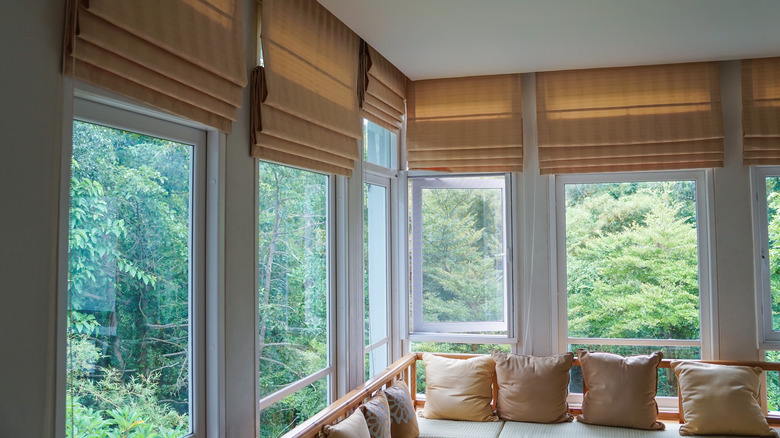Repurpose A Common Household Mainstay Into Beautiful DIY Roman Shades
We may receive a commission on purchases made from links.
Roman shades are always a classic choice when you want to add a simple window covering that blocks out light and adds extra privacy. They offer the ease of traditional blinds while also lending the beauty and elegance of fabric curtains. However, one major drawback to this common window treatment is that they tend to be on the expensive side, with the average price ranging from $30 to $120 per window, according to Home Advisor. When you have multiple windows to cover or window sizes that require custom shades, the costs can add up rather quickly. If you're on a tight budget, there's actually a DIY hack you could use to turn a tablecloth into a super stylish Roman shade. And you don't even have to sew a stitch.
The beauty of using a tablecloth for this project is that they tend to come in heavier fabric weights, similar to drapery fabric, and are therefore more efficient at blocking light and adding privacy. You'd definitely want to avoid using any lightweight tablecloths, such as silk or organza. Also, tablecloths are very affordable and come in a variety of beautiful patterns and colors, so you can get a custom look for a fraction of the price. Other than the tablecloth, you'll just need basic cordless mini blinds (corded mini blinds won't work), a tape measure, pencil, scissors, and hot glue. Keep reading to see how you can make your own Roman shades using a tablecloth and how you can customize it.
How to turn a tablecloth into a Roman shade
Figure out how many fabric folds you want in your shade (7 inches is the recommended spacing between folds). Lay the mini blinds flat and open them up. Snap off the extra slats from the blinds, leaving attached only the few slats that are needed to create the fabric folds. Measure the top width of the blinds and the length of the window, and cut the tablecloth 2 inches wider and 4 inches longer than these measurements. Now, lay the fabric flat with the wrong side facing up, and hem the raw edges by folding over and hot gluing 1 inch of fabric on each side. Place the blinds on top of the fabric, and glue the fabric to the top mechanism of the blinds. Space out your slats evenly, and glue the fabric to them. Finish by gluing the fabric to the bottom of the blinds, and you're done!
There are so many lovely tablecloth options you could use. If you're aiming to decorate your home like an English cottage, you may want to try something like this gingham cotton-blend tablecloth. Looking for something more formal? This damask jacquard tablecloth is an elegant choice and comes in a variety of colors. Or, perhaps you'd like to create a coastal vibe, in which case this striped cotton-blend tablecloth would do just the trick. Want to block out extra light? Simply attach a white tablecloth to the backside of the patterned one before attaching the blinds.
